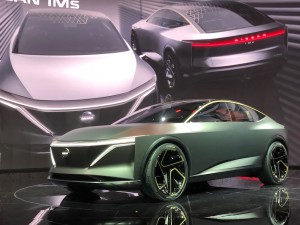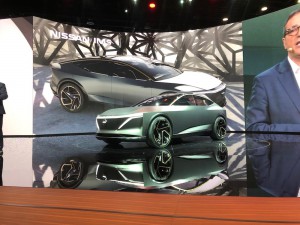
Nissan's IMs concept hits the Detroit Auto Show just after the company rolled out its longest-range Leaf ever.
Barely a week after unveiling the latest – and first truly long-range – version of its Leaf battery-electric vehicle, Nissan is offering a glimpse at where it is “imagining” its future in the form of the all-electric IMs “elevated sports sedan.”
The concept vehicle debuting at the North American International Auto Show pushes the envelope when it comes to three key trends: the shift from sedans and coupes to SUVs and CUVs. It also features a pure BEV drivetrain, a technology Nissan promises will dominate its line-up moving forward. The show car also adds autonomous driving capabilities. Add them together and, Nissan suggests, its future models will feature a distinctly different approach to design, as well.
“Advances in electric vehicle technology and autonomous driving have allowed our designers to break free of the platform and packaging rules that constrain traditional passenger vehicles, to create a completely new type of car,” said Alfonso Albaisa, senior vice president for design at Nissan. “The IMs explores the limits of sedan design with an approach that elevates the category in both look and functionality.”
(Nissan shake-up claims first victim: former U.S. CEO Munoz. Click Here for the story.)
The Jaguar I-Pace already demonstrated what you can do by moving your batteries, motors and other components under the vehicle’s load floor, allowing for a cabin far bigger than what the exterior footprint might suggest. The Nissan IMs goes a significant step further, with its stretched wheelbase allowing for an unusual “2+1+2 seating arrangement.” The front seats can be pivoted when the car is operated in autonomous mode, turning the cabin into a mobile living room.

Nissan's IMs concept offers creative implementation of autonomous technology as well as battery-electric propulsion.
The rear seat can either offer space for three occupants or, with the outboard wings folded back, turned into what Nissan describes as an “indulgent Premier Seat.”
“There is no center console, so when the front seats are turned, the interior becomes an enjoyable, relaxing ‘grand area’ where the occupants can engage with each other in a comfortable way,” said Albaisa. “And the unique rear center seating allows the primary passenger to enjoy the vehicle’s intelligent connectivity features at all times, whether the driver is in autonomous or manual mode operation.”
No surprise, the IMs sits higher up than a typical sedan, reflecting the surge in sales of utility vehicles, but it aims to retain a more sporty feel.
Nissan was one of the first automakers to embrace the idea of autonomous driving, and has been steadily increasing the capabilities of its production models with technologies like the ProPilot Assist found in vehicles such as the new Leaf Plus. The Nissan IMs concept reaches further into the future, to a time when a driver could switch to completely hands-free operation – but it also offers the opportunity to return to manual driving, as well.
(Click Here for more about Nissan boosting the range for the Leaf Plus.)
The Leaf was the world’s first high-volume battery-electric vehicle and has remained the best-selling BEV on the planet, though it is facing growing competition from the likes of the Tesla Model 3, Chevrolet Bolt EV and other new entrants. We can expect to see even more coming from the Japanese automaker as it pushes to regain its momentum, promised Denis Le Vot, the head of Nissan North America.
The IMs “will reveal the next step, the next platform we will have,” Le Vot explained during a conversation in Las Vegas following the debut of the Leaf Plus last week. “You will see how we are imagining our future.”
The IMs features dual electric motors, one on each axle, drawing power from a 115 kilowatt-hour lithium-ion battery pack. That’s enough to not only deliver an estimated range of 380 miles but also a truly sporty driving experience, with 483 horsepower and 590 pound-feet of essentially instant-on torque.
The battery is capable of using new fast-charging technology that should sharply reduce the time it needs to be plugged in.
A technological showcase, the Nissan IMs also introduces what the automaker calls Omni-Sensing technology that, when connected to a roadway infrastructure, can enhance what a motorist would be able to see when operating in manual mode, allowing them to “see what may otherwise be ‘invisible,” the automaker explains. That would include not only information about traffic jams and weather, but even what might be hidden out of sight around a corner. It’s a concept Nissan dubs “Invisible-to-Visible.”
(Infiniti aims to electrify with concept coming to Detroit Auto Show next week. Click Here for a sneak peek.)
While many of the features on the Nissan IMs are still years away from reality, others are “ready for launch,” the automaker suggests. Expect to see the new design approach, in particular, work its way into production as Nissan expands its battery-electric vehicle line-up over the next few years.
